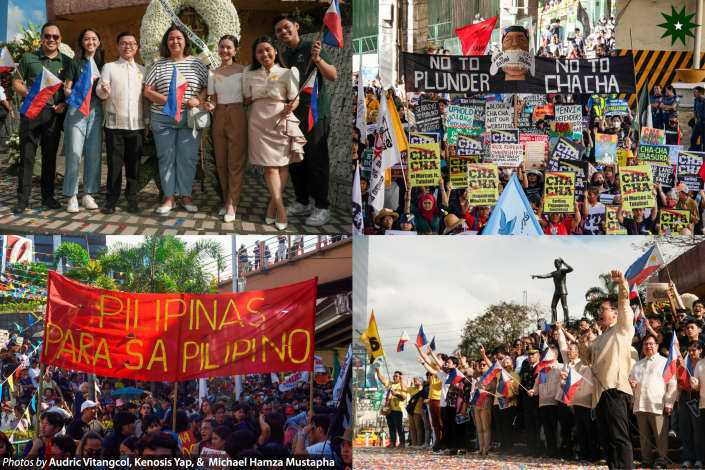Holiday or not, the 38th anniversary of the People Power Revolution was commemorated by thousands who journeyed from the People Power Monument to the EDSA Shrine last February 25 to recapture the spirit of the streets that redefined Philippine democracy 38 years ago.
Last October, President Ferdinand Marcos Jr. excluded the occasion—one reliving his family’s flee from Malacanang in humiliation—from the list of official holidays supposedly because it fell on a Sunday. Regardless, crowds came; opposition groups from various sectors gathered; and sector leaders spoke of never forgetting the past and continuing the battles of the present.

A solemn morning
The day began with a brief wreath-laying ceremony at the EDSA People Power Monument led by the National Historical Commission of the Philippines (NHCP). In attendance were representatives from organizations dedicated to honoring the victims of Martial Law such as the Bantayog ng mga Bayani Foundation Inc., Human Rights Violations Victims’ Memorial Commission, Spirit of EDSA Foundation, August Twenty-One Movement, and the Chino Roces Foundation.
The University Student Government (USG) also partook in the ceremony. Vice President for External Affairs Macie Tarnate told The LaSallian that they reached out to the NHCP in hopes of having student and youth representation in the event. “Nakikita naman natin na ang kabataan nga talaga ay ang kinabukasan ng bayan,” she said. “This is a very simple way na maipakita natin ‘yun.”
(We see that the youth hold the future of this country. This is a very simple way to demonstrate that.)
A charged afternoon
Activities continued in the afternoon with a short program among youth groups. Protestors amassed outside a commercial establishment across the EDSA People Power Monument. There, youth leaders shared their apprehensions toward the proposed charter change and voiced their solidarity with TomasinoWeb, a student media organization. TomasinoWeb recently had to halt its operations after the resignation of its faculty adviser, citing UST’s Office for Student Affairs order to take down a recent viral photo and issue a public apology.
Demonstrators then moved to Rochester St. cor. EDSA, where a truck served as a makeshift stage for the continuation of the program. While sector representatives shared their plight under the current Marcos administration, ADHIKA Southern Tagalog Chairperson Clyde Naranjo recounted a harrowing incident: that just hours before, attendees in caravans in Laguna and Cavite were blocked and beaten by state forces.
At the end of the first part of the program, the crowd marched toward EDSA Shrine, where they were met by droves of policemen, though no clashes occurred between the groups for the remainder of the afternoon. The Quezon City Traffic and Transport Management Department told The LaSallian that around 4,000 people were present for the afternoon activity.
The program resumed with another slate of performances and speeches from opposition figures. Former Sen. Leila de Lima, Kabataan Partylist Rep. Raoul Manuel, human rights lawyer Neri Colmenares, and Association of Faculty and Educators of DLSU Inc. President David Michael San Juan were just a few of the notable speakers who spoke on behalf of their sectors. While they came from different backgrounds, they demonstrated that they all agreed on one thing: charter change will not solve the problems of the Filipino people.
Following the protest, the demonstrators marched to White Plains Ave. near the People Power Monument to attend the “EDSA Kahit Saan” concert that continued until 9:05 pm, coinciding with the exact time that the late dictator Ferdinand Marcos Sr. escaped from Malacañang.
An ‘unfinished’ revolution
The essence of EDSA does not end at the ouster of a dictator, and so its spirit is one of a fight that transcends generations. In an interview with The LaSallian, Atty. Luke Espiritu, president of the Bukluran ng Manggagawang Pilipino, maintained that the EDSA Revolution is unfinished. “Hindi naman natin na-resolve ang lahat ng kuwestiyon sa ating lipunan, kaya tuloy ang pakikibaka,” he said, adding that the youth must continue the fight.
(We have not resolved all our problems in society, so the struggle continues.)
College Editors Guild of the Philippines National Spokesperson Brell Lacerna stressed that the anniversary serves as a reminder of the critical role of the campus press, citing Eman Lacaba and Lorena Barros, writers who were killed under Martial Law.
The outsized role of the youth was also not lost on Colmenares, himself a student activist during the Marcos regime. “The youth has always been an important part of the EDSA spirit,” he noted. “I see na hanggang ngayon, malakas pa rin ang kanilang papel, for EDSA is about the future, too.”
(I see that until now they still play an important role, for EDSA is about the future, too.)
But for the youth to remember the revolution, de Lima asserted that it is important for them to be educated by getting involved and reading up on what happened. “Importante na i-continue ‘yung awareness ng ating mga kabataan kasi hindi talaga nila na-witness ang napakahalagang parte ng ating kasaysayan,” she expounded.
(It is important to continue the youth’s awareness because they did not bear witness to that important part of our history.)
Bagong Alyansang Makabayan president Renato Reyes briefly summarized the event’s spirit, stating, “That’s the whole point of EDSA, ‘di ba? The power of the people is greater than the people in power.”
